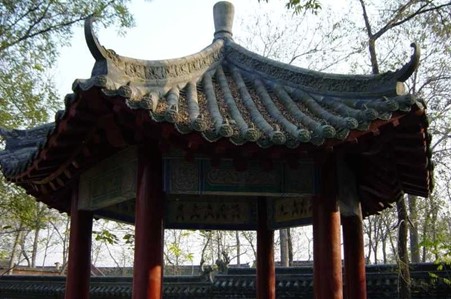
Above is a photo of an ornate pagoda in a historic training area in the famous Chen village – Chen Jia Gou.
If you look closely, you can see pictures inside of figures practicing Tai Chi.
Where did Tai Chi Chuan come from?
There are a lot of legends about the origins of Tai Chi – some more likely to be fiction than others. One story is of a Taoist monk called Chang San Feng, who watched a crane attack a snake and was impressed with the way the snake used circular, coiling movements to avoid the direct strikes of the crane’s beak. From that, he developed a martial art that employed similar movements which became Tai Chi. No-one knows how true this story may be – elements of the story may be true, other parts are more likely to be embellishments.
Another story which is well documented is that of a General in the medieval Chinese army – Chen Wangting – a keen martial artist who created an art that as well as being useful for self defence, also followed principles of Chinese medicine in order to promote health. The art he created became known as the Chen style of Tai Chi – named after his family and was taught at his ancestral village – Chen Jia Gou, in rural Henan province.
The Chen family still teach at the village, and students come from miles around to live at the school & join the local children learning traditional Tai Chi. What they learn looks very different to the style practiced by the red suited people in the BBC advert (Yang style Tai Chi) – it mixes slow movements with more energetic moves, and emphasises a development of relaxed energy release from a very mobile, stable stance. There’s also a big emphasis on push hands practice – a little like judo – to develop things like timing and leverage in applications.
Over time, although the Chen family closely guarded their art, only allowing family members to learn, eventually in the 19th century an outsider – Yang Luchan – learned the style and was permitted to teach it to others. At the same time, he modified it to suit himself, and successive students changed it further and taught it to their students, until the current main styles emerged:
The Yang style is probably the most widely taught in the world – ‘invented’ by Yang Luchan from the Chen style, but modified by his students into the style taught more commonly today. Overall, today there are none of the fast movements of the Chen style, and the stance is higher – less difficult physically, however this doesn’t mean that its ineffectual for self defence.
The Wu, Hao, Sun styles are less well known, but also have distinct characters because of the different ways they have developed.
Why is it sometimes written as Tai Chi without the Chuan part?
In Chinese, Chuan means ‘fist’ or ‘martial art’. Because some teachers don’t teach this aspect, they usually drop the chuan part and just call it Tai Chi. Others are just lazy (that’ll be me) when they’re writing Tai Chi over & over, and sometimes miss it out.
What’s this site for?
My aim is to help people to understand what they can get out of Tai Chi Chuan.
I’m by no means a master, but I’ve got a fair amount of knowledge and I hope I can give a good idea of what Tai Chi is all about and how people can benefit from it.
This site is aimed at my students and is designed to complement what I teach our classes.
Having said that, as far as I’m concerned, everyone’s free to browse around and take from it whatever they can.
However, if you download and use anything on this site for yourself, please credit me as the source – thanks.
